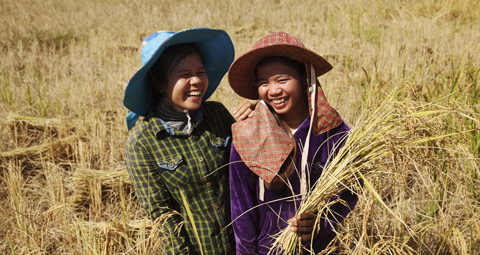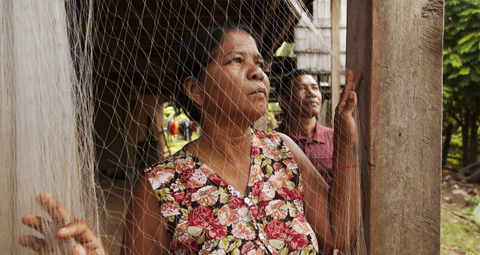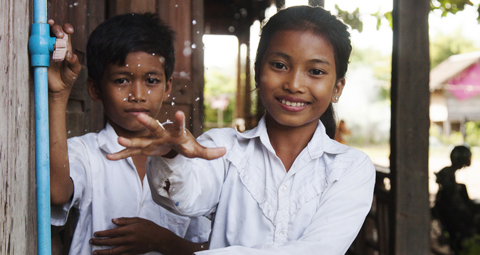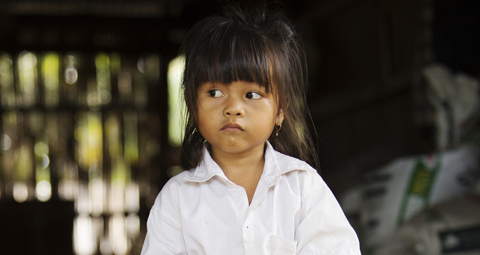BY Daniel Harkins | February 19 | ![]() 0 COMMENTS
0 COMMENTS ![]() print
print

The Lent campaign sowing seeds of hope in Cambodia
Reporting from Cambodia, DANIEL HARKINS speaks to the family featured on SCIAF’s Wee Box this Lent, and explains the struggles they face in a country with a long history of horrific war
Imagine you lost a quarter of your income. Unexpectedly and without warning. How would you cope? Most of us wouldn’t. This is essentially what happened to Phong Lang and his wife Chend Toma. They are farmers living in a village in rural Cambodia with four of their five children. They depend on the rains—the whims of the climate—to feed themselves and their family. Last year, the rains didn’t come as expected. Their harvest fell from four tonnes to 1.5. They struggled to survive.
But the Lang family had a lifeline. SCIAF, Scotland’s Catholic aid agency, is providing support to the Lang’s Stung Treng region in rural northern Cambodia, and thanks in part to the funds collected from parishes and schools in this country, the increasingly capricious nature of the seasons can be defied.
I spoke to the Langs in their home in Kampun village. They built their wooden house themselves, and it is impressive. Raised on stilts, an odd number of stairs—it’s bad luck to have an even number—lead into an open room for the six family members.
Outside, the house is surrounded by greenery, with the Langs’ patch of land roughly separated from other houses in the village with low wooden fences. Chickens wander freely in the grounds, and a dirt road outside links the village to the small town of Stung Treng around 30 minutes away.
It’s peaceful, and seems idyllic. The Langs’ beautiful three-year-old granddaughter Linda wanders around curiously and during our visit the place is a bustling community of villagers.
But life here is tough. Global warming makes the future hard to predict. I asked Lang to think back to a few years ago, before SCIAF and their local partner Development and Peace in Action (DPA) began to help in the region, and ask him what was the most difficult part of his life.
“Everything,” he said. “There was no water, no toilet even—we had to go in the bush.”
Toma added: “The children got diarrhoea and swollen stomachs from drinking contaminated river water. And people would get bitten by snakes from going to the toilet in the bush.”
As hard as it could be, things were once much worse here. In the 1970s, the village was ruled by the genocidal communist Khmer Rouge. Cambodia has had a troubled history since it became an independent nation in 1953.
The country was dragged into the Vietnam War, as North Vietnamese communists began funnelling resources to the battlegrounds of the south through Cambodia on what became known as the Sihanouk Trail. The US military began mercilessly bombing Cambodia. Stung Treng, not far from the Vietnamese supply routes, was badly hit.
“There were so many bombs,” Lang, who was 10 years old at the time, said. “The planes came often and we would run and hide in a hole near the river. Some people were killed in the village and there was lots of damage.”
Things would only get worse. The American bombing of Cambodia created the conditions for Pol Pot’s Khmer Rouge to seize control of the country.
The communists believed in the purity of an agricultural life and began executing intellectuals and force evacuating people from the cities into rural areas.
Lang and Toma remember the influx of people to their village, and the suffering they faced.
“ It was a very hard life,” Lang said. “We were forced to work, and only got a small bowl of rice a day. Everyone was forced together and would be killed if we refused. We were split up from our parents, and put in a children’s group and given lighter work. There was no time to be with our parents.”
Toma said: “If we did not work hard the Khmer Rouge would blame us as an enemy spy and we would be killed.”
Bu Sunnthana, 67, also lived in the village during the Khmer period. The communists killed her father for being a teacher. When she gave birth, she was given just seven days rest before being put back to work felling trees. Her baby was separated from her, and she couldn’t breastfeed her.
“She survived but she was never a healthy child,” Sunnthana said. “She died aged 22.”
More than 100 people from the village would be murdered. Eventually, that total would include Toma’s brother. Forced into the Khmer Rouge army, he disappeared while Toma was 12. Only decades later would the government inform her that her brother had died during the fighting.
As children, Lang and Toma knew each other, but they would be separated when Lang was conscripted into Cambodia’s military, to fight in the civil war that followed a Vietnamese invasion and the collapse of the Khmer Rouge. He returned, and married the girl who had endured so much horror with him.
The family now survive in part thanks to SCIAF funding. In addition to training in farming techniques and the provision of a toilet, a water well and supplies, Kampun village has a SCIAF-funded Community Fishing Authority (CFA). The villagers rely on the river in hard times, particularly when a harvest falls short. But outside gangs—some made up of former military—would decimate the fishing stock by using dynamite and electric poles to catch their haul.
CFA and police patrols have helped reduce the problem. Lang last witnessed illegal fishing last year. “I did not see with my own eyes because I was so afraid but I could hear the dynamite,” he said. “I was scared and expected they would have guns.”
This year, the cord anchoring Lang’s boat to the shore was cut, leaving him unable to fish. He suspects the culprits were people angered at the success of the CFA.
Such assistance from SCIAF is relatively simple, but far more complex is their work helping villagers and indigenous communities gain the right to their own land. A complex bureaucratic system has to be navigated and outside companies prey upon the native communities’ lack of knowledge.
Not far from Kampun village, on a hill overlooking the beautiful bucolic Cambodian countryside, I speak to Koe Cheoun, 36, from the Community Forestry Association.
The land we are standing next to, across a small fence, was owned by local villagers, but the lack of legal ownership allowed outside businesses to take it from them. The company first bought a one hectare piece of land legally from a villager, and then expanded into six hectares of community-owned land.
“They fear taking the land back,” Cheoun said. “They fear being shot: in another community one person was shot dead [over land grabbing]. Here today some community members are still being threatened.”
Businesses use the courts to intimidate the community—making false claims of defamation—and have left threatening messages.
DPA now acts as a link between the villagers and the local authorities, helping them gain legal ownership of the land they live and work on.
SCIAF emphasises that their work is about assisting locals to help themselves and work with each other.
Lang’s daughter Lang Chulen, 22, embodies this cooperation. She has started volunteering in her community, working on sanitation and other local issues, and is a member of a committee tasked with conserving the local area. Along with her sister, she had to leave school to work in her parents’ fields—the family couldn’t survive without the extra help.
“I was very sad that I couldn’t get a good education,” she said. “My dream was to become a teacher.”
Chulen now teaches as a volunteer at the local kindergarten. “I’m happy that I can share my knowledge with the next generation,” she said. “But the problem is I cannot get a good job and even some villagers who graduate high school cannot get a good job.”
Later, I travel with Chulen and her sister Lang Thongtheng, 17, to a field were they work. It is uncomfortably hot and there is little shade. But the Lang sisters work in this field from seven in the morning to five in the evening.
Throughout Lent, you will see the faces of Chulen, Thongtheng, their siblings and their parents, Phong Lang and Chend Toma.
They will appear on SCIAF’s Wee Box, and in the promotional material. We’re guilty—or at least, I certainly am—of barely paying attention to the faces of the people in charity leaflets and television adverts. But they are real people, with real stories, histories, struggles, hopes and dreams.
When you donate money to SCIAF, or put a pound in a Wee Box, you are directly helping the Langs preserve their fishing waters, farm their land, and fight back against criminals and predatory land-grabbers. You are reducing the hours 18-year-old Thongtheng has to work in the exhausting heat, and giving Chulen the opportunity to achieve her goal of becoming a teacher.
When I ask the Lang parents—who have never left the Stung Treng region—if they’d like to come to Scotland, they laugh enthusiastically. “We’d like to come,” they say, “but we don’t know the way!”
Through SCIAF, you can help build them a path.
– To get a SCIAF Wee Box or find out more visit www.theweebox.org or call 0141 354 5555













